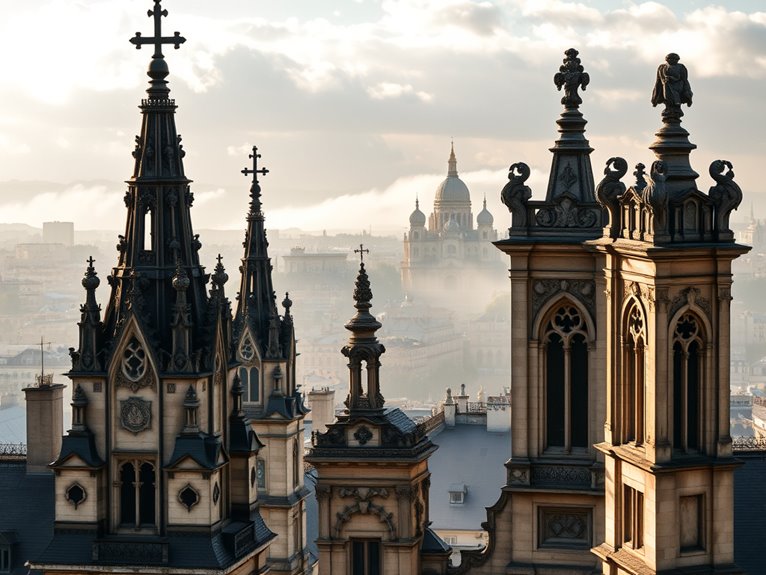
7 Unique Bell Towers in Paris With Panoramic Views
Paris's bell towers offer incredible panoramic views you won't want to miss! I've explored seven stunning options, from Notre-Dame's 69-meter South Tower with its famous gargoyles to Sacré-Cœur's 83-meter summit in Montmartre. Each tower brings unique perspectives – imagine standing next to the 13-ton Emmanuel Bell or climbing Saint-Jacques's 300 steps for a perfect cityscape. Let's explore these architectural marvels that showcase Paris from angles most tourists never see.
Notre-Dame's South Tower: A Medieval Marvel Above Paris
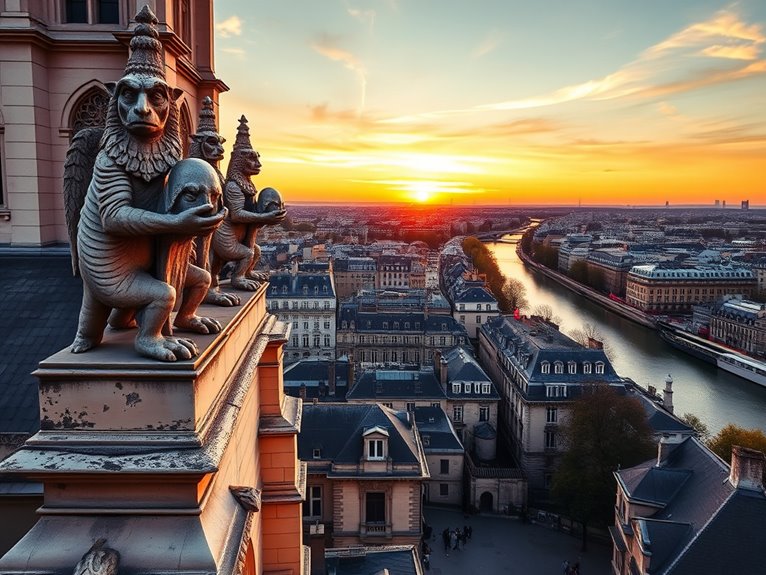
Standing sentinel over Paris for over eight centuries, Notre-Dame Cathedral's South Tower represents one of the finest examples of French Gothic architecture and offers visitors an unparalleled glimpse into medieval Paris. This 69-meter-high structure, completed in 1250, serves as both an architectural masterpiece and a historical time capsule that has witnessed countless notable moments in Parisian history.
The South Tower experience transcends typical cathedral visits by offering visitors the chance to climb 387 steps through narrow spiral staircases, passing gargoyles and chimeras before reaching a viewing platform that provides spectacular vistas of Paris. While currently undergoing restoration following the 2019 fire, the tower's scheduled reopening promises to restore one of the city's most cherished architectural experiences.
Quick Facts:
- Best visiting times: Early morning (8-10 AM) or late afternoon (4-6 PM)
- Traditional admission: €10 (adults), free for under 18
- Photography: Permitted, tripods restricted
- Climbing duration: 30-45 minutes
- Physical requirement: Moderate fitness level needed
- Seasonal considerations: Less crowded in winter months
- Advance booking: Recommended during peak season
Notable Features:
The Emmanuel Bell, housed in the South Tower, ranks among the most famous bells in France. Cast in 1681, this 13-ton bronze masterpiece produces a distinctive F-sharp tone and traditionally rings for major religious celebrations and noteworthy national events. Visitors can observe the bell up close during the climb, though timing visits with its ringing requires advance planning.
The Gargoyle Gallery, positioned two-thirds up the tower, offers an intimate encounter with these medieval rain spouts turned iconic sculptures. These grotesque figures, each unique in design, provide excellent photo opportunities and demonstrate the remarkable craftsmanship of medieval stonemasons. An often-overlooked detail: several gargoyles feature modern repairs, identifiable by their slightly different stone coloring.
Pro Tips:
Timing visits with sunset offers the most dramatic photography opportunities, as the golden hour illuminates both the gargoyles and the cityscape beyond. For prime experiences, visit on clear days after rainfall when visibility extends to the city's furthest landmarks. Carrying a small flashlight proves useful in the darker sections of the spiral staircase, and wearing comfortable, non-slip shoes is essential for the climb.
Practical Considerations:
Post-restoration access will likely require advance reservations through the cathedral's official website or authorized tour operators. Visitors should arrive 15 minutes before their scheduled time slot and be prepared for security screening. The climb isn't suitable for those with claustrophobia or mobility issues, and children under 8 must be accompanied by adults. Weather conditions greatly impact the experience – check forecasts and consider rescheduling during extreme weather events.
Saint-Jacques Tower: The Gothic Guardian of Le Marais
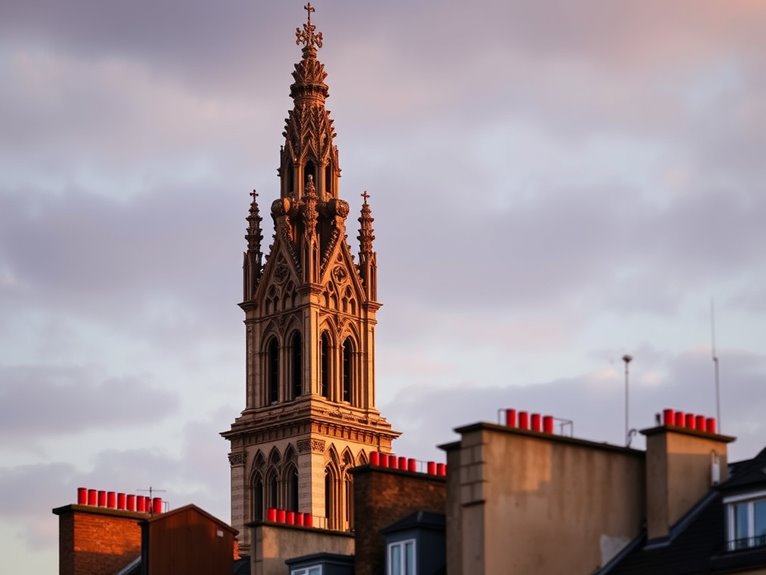
Standing alone in a small square in Paris's Le Marais district, the Saint-Jacques Tower rises like a solitary sentinel, a masterpiece of French Gothic architecture that has witnessed centuries of Parisian history. This 52-meter-high tower is all that remains of the former Church of Saint-Jacques-de-la-Boucherie, which was destroyed during the French Revolution, leaving behind this remarkable indication of medieval craftsmanship.
The tower's survival through centuries of urban development and revolutionary turmoil makes it an extraordinary landmark, decorated with intricate sculptures, including symbols of the four evangelists and various saints. Its recent restoration has renewed interest in this architectural gem, offering visitors a unique perspective on Paris's medieval heritage and providing exceptional views of the city for those willing to climb its 300 steps.
Quick Facts:
- Opening Hours: Tuesday to Sunday, 10:00 AM – 5:30 PM (closed Mondays)
- Best Visit Times: Early morning or late afternoon for prime lighting
- Admission: €10 for adults, €8 for students
- Photography: Best shots from Square de la Tour Saint-Jacques
- Guided Tours: Available in French and English
- Accessibility: No elevator, spiral staircase only
- Visit Duration: 45-60 minutes recommended
The Tower Experience:
The ascent of Saint-Jacques Tower offers an intimate encounter with Gothic architecture. Each level reveals different architectural elements, from elaborate gargoyles to delicate stonework. The spiral staircase, though challenging, provides access to multiple platforms where visitors can observe the tower's astronomical symbols and weather vane, installed in the 19th century for scientific measurements. Insider tip: Look for the small medieval graffiti carved into the stone walls by ancient craftsmen.
Viewing Platform:
The tower's summit rewards climbers with a 360-degree panorama of central Paris. The viewing platform, though compact, provides unique angles of Notre-Dame, the Eiffel Tower, and Sacré-Cœur. The platform features educational panels explaining the tower's role in Paris's history and identifying major landmarks. Little-known fact: The tower was once used as a weather station by notable scientists, including Blaise Pascal for his atmospheric pressure experiments.
Pro Tips:
Book tickets online at least two weeks in advance, as access is limited to small groups. Visit during shoulder season (April-May or September-October) for fewer crowds and pleasant weather. Photographers should aim for the "golden hour" just before sunset when the surrounding buildings cast interesting shadows and the stone takes on a warm glow. Consider timing your visit with guided tours that include historical reenactments, typically offered on weekends during summer months.
Practical Advice:
Wear comfortable shoes with good grip for the spiral staircase climb. Bring a water bottle and light jacket (it can be windy at the top). The tower isn't suitable for those with mobility issues or severe claustrophobia due to the narrow, winding staircase. Storage lockers are available at the base for small bags, but large backpacks aren't permitted. Consider combining your visit with exploration of the surrounding Marais district, known for its medieval architecture and vibrant cultural scene.
Saint-Sulpice's Twin Towers: Hidden Gems of the Left Bank
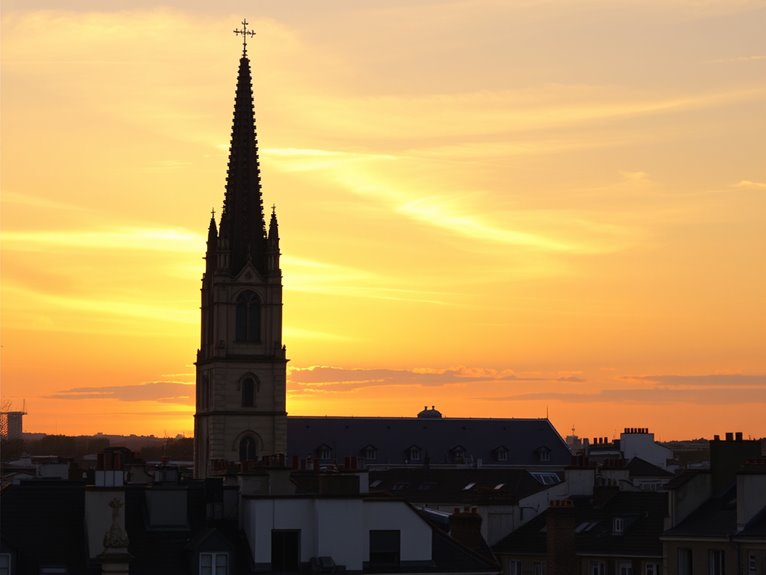
Standing majestically in Paris's 6th arrondissement, the towers of Saint-Sulpice Church represent one of the city's most intriguing architectural features, often overshadowed by their more famous cousin, Notre-Dame. These mismatched towers, completed at different times in the 18th century, tell a fascinating story of architectural evolution and Parisian history, rising 73 meters above the charming streets of the Left Bank.
While tourists flock to more prominent landmarks, Saint-Sulpice's towers offer visitors a unique perspective on Parisian church architecture and an opportunity to explore one of the city's largest churches. The northern tower remains unfinished, creating an asymmetrical appearance that distinguishes these towers from other Parisian church spires and making them a photographer's delight, especially during golden hour.
Quick Facts:
- Visiting Hours: 7:30 AM – 7:30 PM daily
- Tower Access: Limited guided tours available
- Best Photography Time: Late afternoon for ideal lighting
- Admission: Free for church entry; tower tours €8
- Nearest Metro: Saint-Sulpice (Line 4)
- Photography: Allowed without flash
- Best Viewing Spots: Luxembourg Gardens, Rue Férou
The Northern Tower
The unfinished northern tower stands as an indication of the church's complex construction history. Its incomplete state resulted from financial constraints during the French Revolution, creating an unintentionally unique architectural feature. Visitors can observe the distinctive stone craftsmanship and original construction techniques from the 18th century. Insider tip: The northern tower offers the best angles for photography from the small square on Rue Palatine.
The Southern Tower
Completed in 1749, the southern tower showcases the intended design for both towers. Housing a grand bell weighing over six tons, this tower demonstrates the pinnacle of French classical architecture. The tower's viewing platform, accessible during guided tours, provides spectacular views of the Latin Quarter. Lesser-known fact: The tower contains a small museum displaying original architectural plans and construction tools.
Pro Tips:
Visit during organ recitals (typically Sundays at 10:30 AM) to experience the church's famous organ while admiring the towers' interior architecture. For photographers, the best shots can be captured from the northeastern corner of Luxembourg Gardens during the "blue hour" just after sunset, when the towers are dramatically lit against the darkening sky.
Practical Advice:
Book tower tours at least two weeks in advance through the church office, as spaces are limited to 15 people per tour. Wear comfortable shoes with good grip, as the tower stairs are original and worn. Bringing a wide-angle lens is essential for photographers, as the narrow surrounding streets make it challenging to capture the towers' full height in a single frame.
Sacré-Cœur's Bell Tower: Montmartre's Highest Point
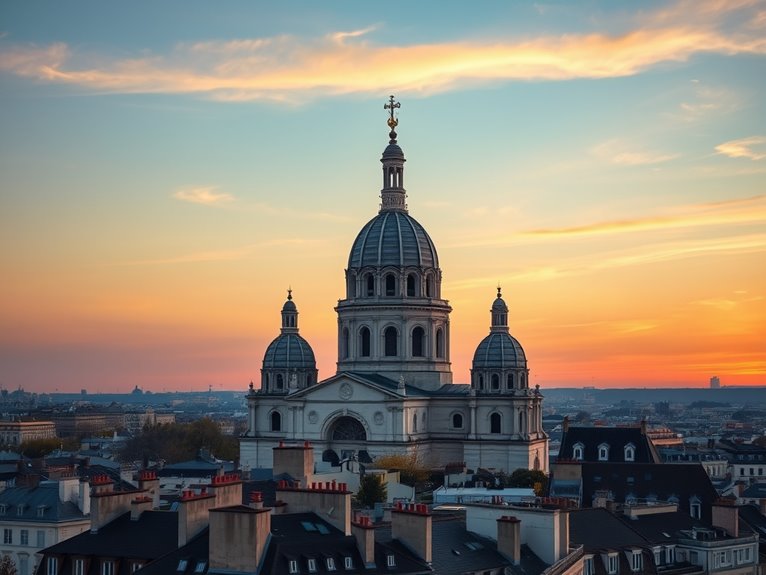
Standing proudly atop the highest hill in Paris, the bell tower of the Basilica of the Sacred Heart (Sacré-Cœur) serves as both a spiritual beacon and an architectural marvel. Rising 83 meters above the already elevated Montmartre district, this Romano-Byzantine tower houses La Savoyarde, one of the largest bells in France, and offers visitors an unparalleled 360-degree view of the City of Light.
The tower's construction, completed in 1914, represents a remarkable feat of engineering and artistic vision, incorporating unique acoustic properties that allow the bell's resonant tones to be heard across Paris. Visitors who venture to explore this iconic structure discover not just a bell tower, but a symbol of French craftsmanship and a vantage point that has inspired artists and photographers for generations.
Quick Facts:
- Opening Hours: 8:30 AM – 8:00 PM (May to September); 9:00 AM – 5:00 PM (October to April)
- Admission: €6 for adults, free for children under 12
- Best Visiting Time: Early morning or just before sunset
- Photography: Tripods allowed only with special permission
- Physical Requirements: 300 steps to climb, no elevator
- Weather Consideration: Tower may close during inclement weather
- Duration: Allow 45-60 minutes for the complete experience
The Bell – La Savoyarde
The tower's crown jewel, La Savoyarde, weighs an impressive 19 tons and measures 3 meters in diameter. Cast in Annecy in 1895, it remains one of the world's most remarkable church bells. Insider tip: Visit during the quarter-hour strikes for a unique photo opportunity when the bell mechanism is in motion.
The Observation Deck
The tower's observation platform provides one of the few opportunities to view Paris from above while still being close enough to distinguish landmark details. Unlike the Eiffel Tower's distant perspective, this vantage point offers intimate views of Montmartre's rooftops and the city beyond. The platform accommodates up to 30 visitors at once, creating a more personal viewing experience.
Pro Tips:
For the most memorable experience, time your visit for the "blue hour" – approximately 30 minutes after sunset. The lighting conditions during this period create perfect conditions for photography, while the city lights begin to twinkle below. Additionally, visiting during weekday mornings typically means shorter queues and more space to explore at your own pace.
Practical Advice:
Wear comfortable, non-slip shoes and bring a water bottle for the climb. Consider purchasing tickets online to avoid queues, particularly during peak tourist season (June-August). The tower's entrance is separate from the main basilica entrance – look for signs directing to "Tour de la Basilique" on the right side of the building. During summer months, the last admission is 45 minutes before closing time.
Saint-Germain-des-Prés: The Oldest Bell Tower in Paris
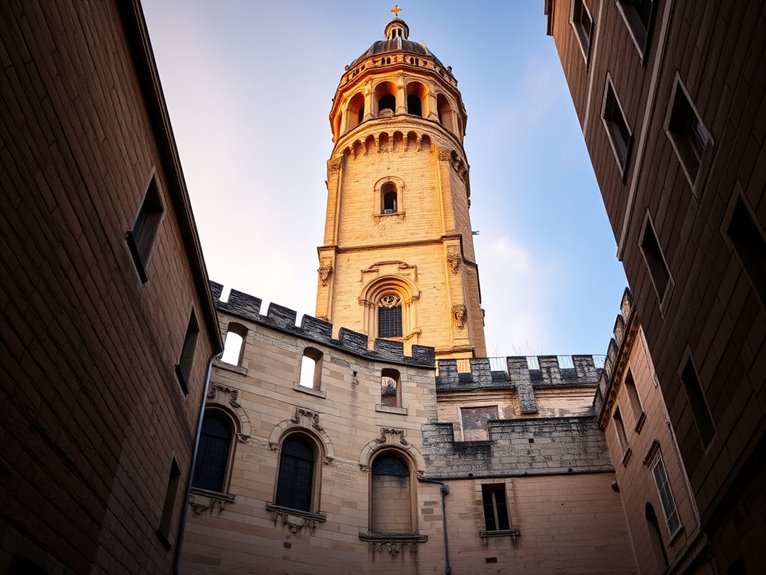
Standing proudly in the heart of Paris's Left Bank, the bell tower of Saint-Germain-des-Prés Abbey holds the distinguished title of being the oldest in Paris. Dating back to the 11th century, this Romanesque tower has witnessed nearly a millennium of Parisian history, surviving revolutions, wars, and numerous architectural transformations of the city.
This architectural marvel not only represents an essential piece of Paris's religious heritage but also serves as a demonstration of medieval engineering and craftsmanship. Its weathered stones and distinctive square shape tell stories of the Merovingian dynasty, the evolution of Christian architecture in France, and the development of Paris as a cultural center. Today, visitors can explore this historical landmark while experiencing the vibrant Saint-Germain-des-Prés neighborhood that surrounds it.
Quick Facts:
- Best visiting hours: 8:30 AM – 7:30 PM (daily)
- Photography permitted: Yes (no flash during services)
- Admission: Free for tower viewing from exterior
- Guided tours: Available Tuesday and Thursday afternoons
- Accessibility: Limited (narrow stairs to tower viewing areas)
- Best photo opportunities: Early morning or late afternoon
- Nearest Metro: Saint-Germain-des-Prés (Line 4)
Historical Significance:
The bell tower rises 45 meters high and represents one of the finest examples of Romanesque architecture in Paris. Originally part of a larger abbey complex, it survived the French Revolution when much of the original structure was destroyed. The tower houses three historic bells, including one dating from 1530, which still rings for special occasions and services.
Architectural Features:
The tower's distinctive square design showcases typical Romanesque features, including rounded arches, thick walls, and small windows. The exterior stonework displays intricate carved details that have survived centuries of weathering. An unusual feature is the tower's slight lean, barely noticeable to the naked eye but a reflection of its age and the settling of its medieval foundations.
Pro Tips:
For the best experience, visit during the "golden hour" just before sunset when the stone takes on a warm, honeyed glow perfect for photography. Consider timing your visit to coincide with the bells ringing, which typically occurs before mass services. The square in front of the church offers excellent vantage points for photos, particularly from the café terraces of Les Deux Magots or Café de Flore.
Practical Advice:
While the tower itself can only be viewed from the exterior, the church interior is worth exploring and provides valuable historical context. Visit on weekday mornings to avoid tourist crowds and enjoy the peaceful atmosphere of this historic site. For those interested in architectural photography, bring a wide-angle lens to capture the tower's full height from the narrow streets surrounding it. Several excellent guided tours of the neighborhood include detailed information about the tower's history and significance in medieval Paris.
Tour Saint-Jacques-de-la-Boucherie: A Renaissance Watchtower
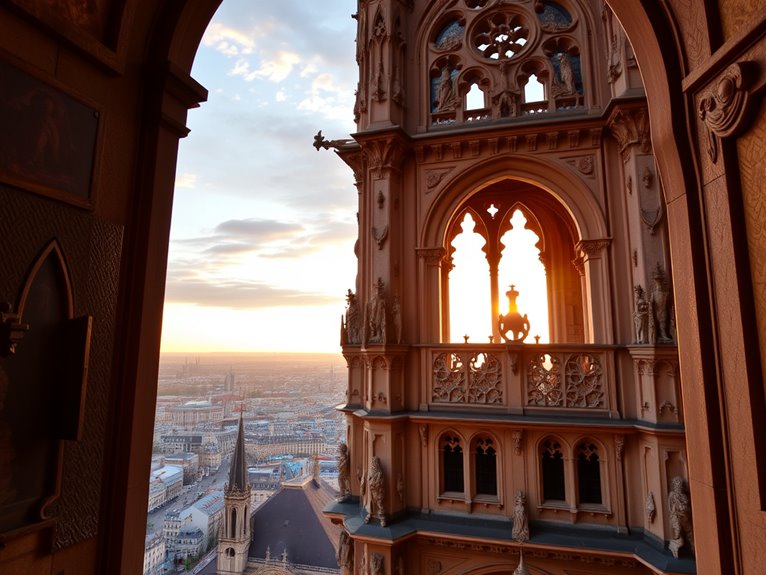
Standing proudly in Paris's 4th arrondissement, the Tour Saint-Jacques-de-la-Boucherie represents one of the finest examples of Flamboyant Gothic architecture in the French capital. This 52-meter-high tower, the only remaining piece of the former Church of Saint-Jacques-de-la-Boucherie, has served as both a religious monument and a scientific observation point throughout its rich history.
Once a vital starting point for medieval pilgrims setting off on the Way of Saint James to Santiago de Compostela, the tower now offers visitors a unique perspective of Paris's historic center. After extensive restoration work completed in 2009, the structure has become an essential stop for architecture enthusiasts and history buffs, providing rare guided tours that showcase both its architectural splendor and panoramic views of the city.
Quick Facts:
- Opening Hours: Seasonal (typically July to September)
- Guided Tours: Friday-Sunday, advance booking required
- Cost: €10 for adults, €8 for reduced rates
- Group Size: Maximum 17 people per tour
- Duration: 50 minutes
- Physical Requirements: 300 steps, no elevator
- Photography: Allowed, tripods permitted with advance permission
- Weather Consideration: Tours cancelled during inclement weather
The tower's most distinctive feature is its elaborate stonework, featuring intricate sculptures of religious figures, including Saint James himself, and symbolic animals. The detailed craftsmanship exemplifies the pinnacle of 16th-century French Renaissance architecture, with each facade telling different biblical and historical stories through its carvings. An insider secret: look for the salamander motif, emblematic of King François I, hidden among the decorative elements.
The viewing platform at the top offers a unique 360-degree perspective of Paris, with unobstructed views of Notre-Dame, the Centre Pompidou, and the Eiffel Tower. The climb includes stops at various levels where guides explain the tower's scientific significance – Blaise Pascal conducted his atmospheric pressure experiments here in 1648, making it a landmark in the history of science.
Pro Tips:
Book tours at least two weeks in advance during peak season (July-August). The best photography opportunities come during the "golden hour" just before sunset, particularly for capturing the play of light on the surrounding Haussmanian buildings. Consider visiting on overcast days when visibility can actually be better for cityscape photography, and crowds are typically smaller.
Practical Advice:
Wear comfortable climbing shoes and bring water – the spiral staircase is narrow and can be challenging. Arrive 15 minutes before your scheduled tour time, as groups depart promptly. The surrounding square provides excellent ground-level photo opportunities of the tower, and the adjacent cafe offers a perfect spot for post-climb refreshments. While waiting for your tour, explore the recently renovated Square de la Tour Saint-Jacques, a peaceful garden that provides excellent views of the tower's base.
Saint-Étienne-du-Mont: The Gothic-Renaissance Hybrid
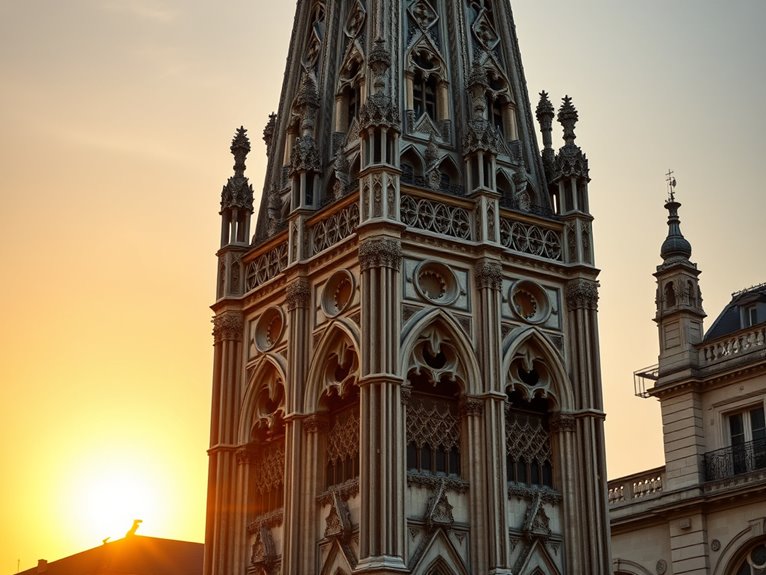
Standing proudly on the Montagne Sainte-Geneviève, Saint-Étienne-du-Mont's bell tower represents one of Paris's most fascinating architectural amalgamations. This remarkable structure, completed in 1624, seamlessly blends Gothic and Renaissance styles, creating a unique silhouette in the Parisian skyline that distinguishes it from its contemporaries.
The bell tower's distinctive character stems from its unusual construction timeline, which spanned multiple architectural periods and resulted in a compelling fusion of styles. Rising 46 meters high, it features delicate Gothic tracery alongside Renaissance columns and decorative elements, making it an essential study for architecture enthusiasts and a testament to Paris's evolving architectural heritage.
Quick Facts:
- Visiting Hours: 10:00 AM – 7:45 PM (Tuesday to Sunday)
- Best Photography Time: Early morning or late afternoon for ideal lighting
- Entry Fee: Free
- Photography: Allowed (no flash during services)
- Accessibility: Limited (spiral staircase to tower not wheelchair accessible)
- Location: 5th arrondissement, near Panthéon
- Guided Tours: Available first Sunday of each month
The Tower's Architecture
The bell tower's most striking feature is its octagonal lantern, which rises from a square base through a series of elegant shifts. The structure incorporates flying buttresses with Renaissance ornamentation, while maintaining Gothic pointed arches. This architectural harmony creates a visual masterpiece that demonstrates the evolution of French religious architecture.
The Rood Screen Connection
Uniquely, the tower's design elements echo the church's famous rood screen (jubé) – the only surviving example in Paris. The intricate stone carving techniques used in both structures showcase the same craftsmen's work, creating a cohesive artistic narrative throughout the building.
The Bells
The tower houses three historic bells, including one dating from 1512, making it one of the oldest functioning bells in Paris. The main bell, named "Anne-Geneviève," weighs 1,700 kg and produces a distinctive F-sharp tone that has resonated over the Latin Quarter for centuries.
Pro Tips:
The ideal viewing position for photographing the tower is from the small square just northeast of the church, particularly during the "golden hour" before sunset when the stone takes on a warm, honeyed glow. Visit during bell-ringing times (typically before mass) to experience the full acoustic impact of the medieval bells echoing through the neighborhood.
Practical Advice:
When visiting Saint-Étienne-du-Mont's bell tower, consider combining it with a visit to the adjacent Panthéon for a thorough exploration of the area's architectural heritage. The church remains an active place of worship, so respect service times and dress modestly. During summer months, early morning visits are recommended to avoid crowds and capture the best lighting for photography.
